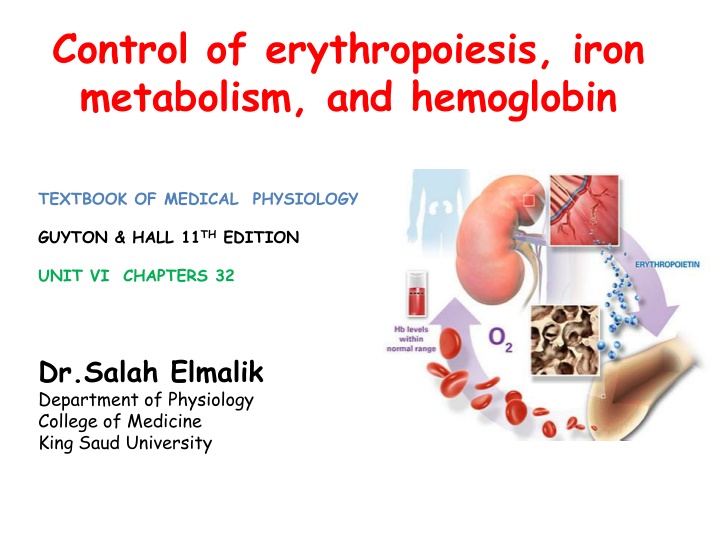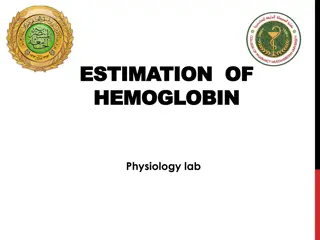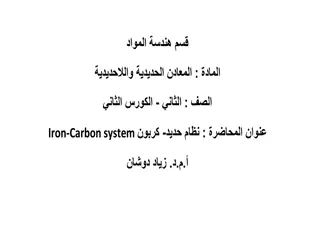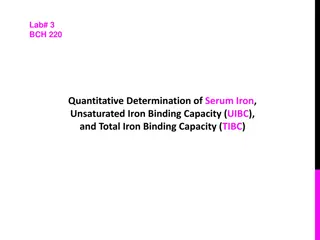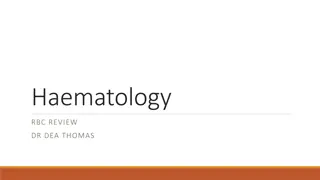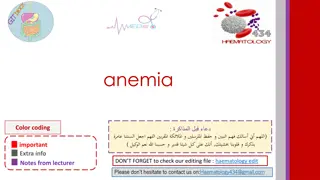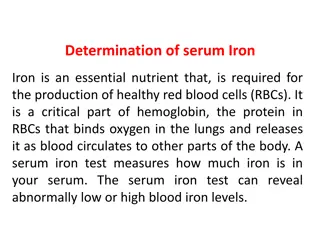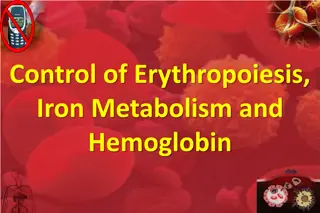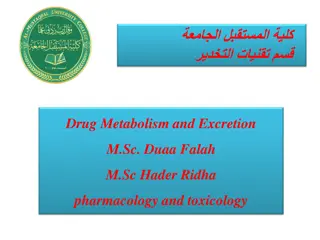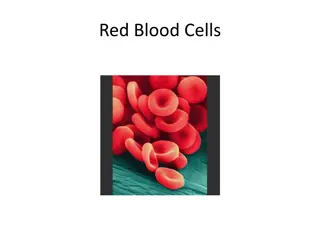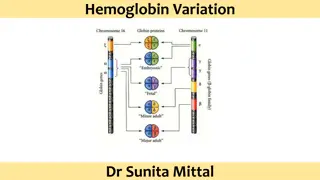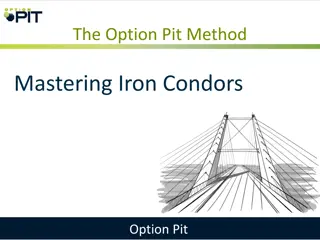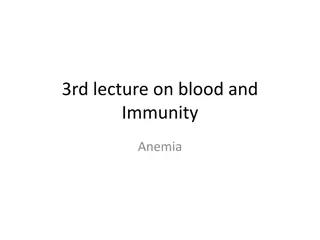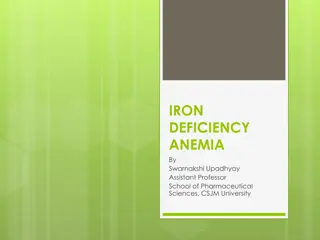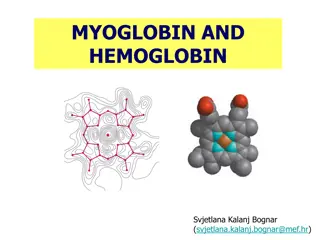Regulation of Erythropoiesis, Iron Metabolism, and Hemoglobin
This content covers the control of erythropoiesis, iron metabolism, and hemoglobin, including essential elements for RBC formation, Vit B12 absorption, hemoglobin structure and function, iron metabolism, causes of anemia and polycythemia, and factors affecting erythropoiesis. It discusses the importance of erythropoietin, vitamins, minerals, amino acids, and hormones in the regulation of RBC production.
Download Presentation

Please find below an Image/Link to download the presentation.
The content on the website is provided AS IS for your information and personal use only. It may not be sold, licensed, or shared on other websites without obtaining consent from the author.If you encounter any issues during the download, it is possible that the publisher has removed the file from their server.
You are allowed to download the files provided on this website for personal or commercial use, subject to the condition that they are used lawfully. All files are the property of their respective owners.
The content on the website is provided AS IS for your information and personal use only. It may not be sold, licensed, or shared on other websites without obtaining consent from the author.
E N D
Presentation Transcript
Control of erythropoiesis, iron metabolism, and hemoglobin http://2.bp.blogspot.com/_XJvgbp0s9as/TQE9C7EOHAI/AAAAAAAAAGs/XR3c0alcsPQ/s640/eryth.jpg TEXTBOOK OF MEDICAL PHYSIOLOGY GUYTON & HALL 11THEDITION UNIT VI CHAPTERS 32 Dr.Salah Elmalik Department of Physiology College of Medicine King Saud University
Objectives of the todays lecture At the end of this lecture student should be able to: 1. Describe essential elements needed for RBC formation. 2. Describe the process of Vit B12 absorption and its malabsorption. 3. Recognize the structure and the function of hemoglobin. 4. Understand the metabolism of iron (absorption, storage and transport). 5. Recognize the causes of anemia and polycythemia.
Regulation of Erythropoiesis Importance Factors affecting Erythropoiesis Tissue Oxygenation Anemia, High Altitudes, heart and lung problems. ERYTHROPOITEN (EPO)
The regulation of RBC production and erythropoietin hormone secretion in response to hypoxia
Regulation of Erythropoiesis Importance Factors affecting Erythropoiesis Tissue Oxygenation Anemia, High Altitudes, heart and lung problems. ERYTHROPOITEN Vitamins Metals Proteins Hormones
Vitamins Vit B12 & Folic acid Essential for formation of thymidine triphosphate Essential building block of DNA Diminished DNA Failure of nuclear maturation Inadequate Erythropoiesis Other vitamins : Vit B6, Riboflavin, nicotinic acid, biotin, Vit C, Vit E
Minerals Iron - Formation of hemoglobin - Deficiency can lead to anaemia Copper Necessary for Iron metabolism Cobalt Forms a part of Vitamin B12 Zinc and Manganesium
Amino acids and hormones Proteins & Amino acids: formation of globin in hemoglobin sever protein deficiency results in anaemia Hormones: - Testosterone - Growth hormone - Thyroid hormone - Cortisol - Adrenocorticotrophic hormone (ACTH)
Vitamin B12 & Folic acid Important for DNA synthesis and final maturation of RBC. Dietary source: meat, milk, liver, green vegetables. Deficiency leads to: - Failure of nuclear maturation & division - Abnormally large & oval shape RBC - Short life span - Reduced RBC count & Hb - Macrocytic (megaloblastic) anemia
Macrocytic anemia Normal blood film Note the hypersegmented neurotrophil and also that the RBC are almost as large as the lymphocyte. Finally, note that there are fewer RBCs.
Malabsorption of Vit. B12 Pernicious Anemia VB12 absorption needs intrinsic factor secreted by parietal cells of stomach. VB12 + intrinsic factor are absorbed in the terminal Ileum. Causes of deficiencies: Inadequate intake Poor absorption due to Intestinal disease
Iron metabolism (Fe) Iron is needed for the synthesis of haemoglobin, myoglobin, cytochrome oxidase, peroxidase & catalase Total Iron in the body = 4-5g 65% .. Hemoglobin 4% .. In the form of myoglobin 1% . other heme-containg proteins 0.1% .. Is combined with transferrin in the bood plasma 15-30% stored iron in the form of ferritin in the liver, spleen and bone marrow.
Iron absorption Iron in food mostly in oxidized form (Ferric, F3+) Better absorbed in reduced form (Ferrous, F2+) Iron in stomach is reduced by gastric acid, Vitamin C. Rate of iron absorption depend on the amount of iron stored
Transport and storage of iron Iron is transported in the plasma in the form of Transferrin (apotransferrin + iron). Iron is stored in two forms: Ferritin (apoferritin + iron) Hemosiderin (insoluble complex molecule, in liver, spleen, bone marrow) Daily loss of iron is 0.6 mg in male & 1.3mg/ day in females.
HEMOGLOBIN (Hb) Each RBC contains 280 million Hb molecules. Hb molecules consist 4 chains each formed of heme & polypeptide chain (globin). Heme consist of porphyrin ring + iron (F2+).
Types of normal Hb: -Hb A (2 alpha and 2 beta chains) (adult Hb) (98%). - Hb A2 (2 alpha and 2 delta chains) (2%) -Hb F (2 alpha and 2 gamma chains) (Hb of intrauterine life). -Abnormality in the polypeptide chain - abnormal Hb (hemoglobinopathies) e.g thalassemias, sickle cell (HbS).
Functions of Hemoglobin Carriage of O2 - Hb reversibly binds O2 to form Oxyhemoglobin, affect by pH, temperatre, H+ Carriage of CO2 - Hb binds CO2 = Carboxyhemaglobin Buffer
Destruction of RBC RBC life span in circulation = 120 days. Metabolic active cells. Old cell has a fragile cell membrane, cell will rupture as it passes in narrow capillaries (and spleen). Released Hb is taken up by macrophages in liver, spleen & bone marrow: - Hb is broken into its component: Polypeptide amino acids (protein pool = storage) Iron ---- stored in liver and bone marrow as ferrtin Heme (Porphyrin)>> bilirubin>> secreted by the liver into bile. [excess destruction of RBC ---Jaundice]
Extravascular Pathway for RBC Destruction (Liver, Bone marrow, & Spleen) Phagocytosis & Lysis Hemoglobin Heme Bilirubin Globin Fe2+ Amino acids Excreted Amino acid pool
ANAEMIAS Definition: Decrease number of RBC Decrease Hb Symptoms: Tired, Fatigue, short of breath, heart failure.
Physiological Causes of anaemia 1.Blood Loss Rapid hemorrhage caused by accident (RBC return to normal 3-6w) Chronic blood loss caused by microcytic hypochromic anaemia (iron) 2.Decrease RBC production Nutritional causes: Iron deficiency results in microcytic hypochromic anaemia. Vit B12 & Folic acid deficiencies result in megaloblastic anaemia. Bone marrow failure: destruction by cancer, radiation, and drugs result in Aplastic anaemia. 3.Haemolytic leading to excessive destruction of RBCs Abnormal cells or Hb Hereditary Spherocytosis anemia sickle cells anemia Erythroblastosis fetalis.
Polycythemia (Increased number of RBC) Types: 1.Primary polycythemia (Polycythemia Vera - (Erythremia): - Uncontrolled RBC production (genetic). - The RBC count can reach 7-8 millions/ mm3 and the hematocrit may be 60 to 70% 2.Secondary polycythemia: secondary to hypoxia caused by high altitude (physiological), chronic respiratory or cardiac disease
